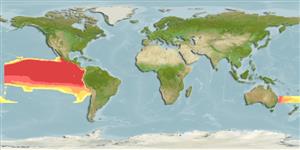Teleostei (teleosts) >
Argentiniformes (Marine smelts) >
Bathylagidae (Deep-sea smelts)
Etymology: Bathylagoides: Greek, bathys = deep + Greek, lagoides = similar to a hare (Ref. 45335).
Environment: milieu / climate zone / depth range / distribution range
Ecology
Marine; bathypelagic; depth range 100 - 1500 m (Ref. 33698), usually 200 - 300 m (Ref. 33679). Deep-water; 22°N - 33°S
Pacific and Indian. Eastern Pacific: California Current region (Ref. 35604).
Size / Weight / Age
Maturity: Lm ? range ? - ? cm
Max length : 10.5 cm SL male/unsexed; (Ref. 96339)
Dorsal spines (total): 0; Dorsal soft rays (total): 10 - 14; Anal spines: 0; Anal soft rays: 14 - 18; Vertebrae: 41 - 46. Deep body, relatively slender toward the end of caudal peduncle; maximum body depth slightly anterior to origin of dorsal fin in specimens 6 - 10.45 cm SL and at the level of the pectoral fin base in smaller specimens. Pectoral fins short, far from reaching origin of dorsal fin. Radial grooves present in the hind part of operculum. Few gill rakers at the inner surface of epibranchial of the first gill arch (Ref. 33679). Branchiostegal rays: 2.
Undergoes daily vertical migrations, rising into the epipelagic zone during the night. Feeds mainly on zooplankton (Ref. 9875, 33698). Oviparous, with planktonic eggs and larvae (Ref. 35604).
Life cycle and mating behavior
Maturity | Reproduction | Spawning | Eggs | Fecundity | Larvae
Gorelova, T.A. and S.G. Kobylyanskiy, 1985. Feeding of deepsea fishes of the Family Bathylagidae. J. Ichthyol. 25(3):89-100. (Ref. 33698)
IUCN Red List Status (Ref. 130435: Version 2024-1)
Threat to humans
Harmless
Human uses
Fisheries: of no interest
Tools
Special reports
Download XML
Internet sources
